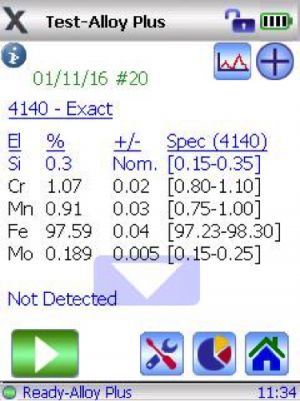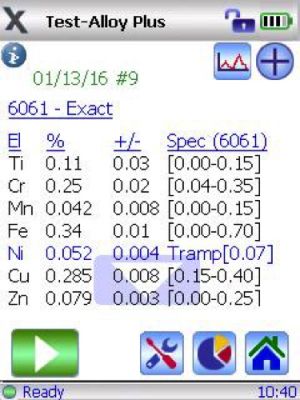Background: The importance of PMI in the auto industry
Using the correct materials for the engineering application is important for preventing material failure. In the auto industry, different materials are often used in the same assembly or in close proximity within a vehicle, so materials can sometimes become mixed. Manufacturers often hold suppliers to a rigid quality process (Pre-Production Approval Process PPAP) that dictates tight controls on all raw materials; if a supplier sends non-conforming alloy or other material, the supplier could potentially lose credibility and revenue. If an automaker finds a supplier deviates from its approved PPAP (i.e. non-conforming material), they halt the production line and charge the supplier for every minute of downtime. However, it is still the auto manufacturer’s responsibility to ensure the integrity of the material used in their products. Auto manufacturers must test incoming materials to ensure quality control and quality assurance.
Testing incoming materials can be challenging for the auto industry when different materials are used for the same part or product, especially when there is no visible difference. X-ray fluorescence (XRF) is an important tool for quality control because it enables inspectors to nondestructively identify and confirm different alloys and metals.
Olympus DELTA Handheld XRF for QC and PMI
The DELTA handheld XRF is ideal for fast and accurate grade verification of metal alloys for the automotive industry. All analyses are completely nondestructive. The DELTA provides alloy composition chemistry (up to 30 elements simultaneously) and grade identification within seconds. The user interface makes it easy to compare test results to engineering grade specifications, so users can quickly identify "out of spec" elements and tramp constituents. Test results can be quickly exported to a database for archiving. The DELTA Reporting Software makes it simple to produce formal analysis reports, or the DELTA analyzer can send results directly to a wireless printer for instant documentation.
DELTA handheld XRF helps automotive manufacturers maintain high quality standards with features including:
- Comprehensive grade Identification: The standard grade library includes more than 500 unique alloy grades. The tramp library, based on industry standards, simplifies grade matching. Users can modify the existing libraries or create their own libraries.
- Fast, sensitive, and accurate light element analysis: The combination of an optimized electronics design, stable X-ray tube, and large area silicon drift detector (SDD) enables the high performance needed for PMI analysis.
- SmartSort for high test throughput: Automatically extend testing time for light elements when necessary and eliminate unnecessarily long tests.
- Efficient heat sink to inspect high-temperature systems: The DELTA is capable of inspecting surfaces up to 800 °F (426 °C).
- Small spot collimator: The optional collimator helps users isolate small features from the background.
- Integrated camera: Save and archive a photographic record of tested surfaces.
Results
DELTA analyzers use a proprietary fundamental parameters-based algorithm with base-specific calibration enabling rapid and accurate light element analysis and very low detection limits for key elements in PMI applications. The following three examples demonstrate the capabilities of DELTA HHXRF for PMI applications in the auto industry.
- Alloy steels 4140 and 4340 are frequently used for high-strength applications such as crankshafts, gears, splines, and axles. Figure 1 illustrates the material chemistry results for both alloys using a DELTA analyzer. With these alloys, the chromium and molybdenum specified ranges overlap, potentially causing confusion in identification. However, DELTA XRF analyzes the nickel content of 4340 easily, enabling positive identification of these two similar alloys.
Figure 1. A comparison of 4140 and 4340 alloy steels with DELTA XRF.
2. Stainless steel alloys 304 and 303 are used in heat and corrosion-resistant applications, as well as for fasteners. The machining differences between these two similar alloys are dramatic. Elemental ranges largely overlap, except for the presence of sulfur in 303, which the DETLA can detect to accurate distinguish between the two alloys.
Figure 2. A comparison of 304 and 303 stainless steels.
3. Two very common aluminum grades used in very different applications: 6061 is used for structural parts and strength-requiring applications while 6063 is used for trim and body panels. DELTA XRF detects the copper content of 6061 to distinguish between these two alloys.
Figure 3. A comparison between 6061 and 6063 aluminum grades.
Conclusion
Handheld XRF technology quickly and accurately identifies commonly used alloys in many automotive applications. The Olympus DELTA helps inspectors ensure proper process control and specified material compliance in fabrication, machining, assembly operations, or wherever the supply chain can benefit from use.







